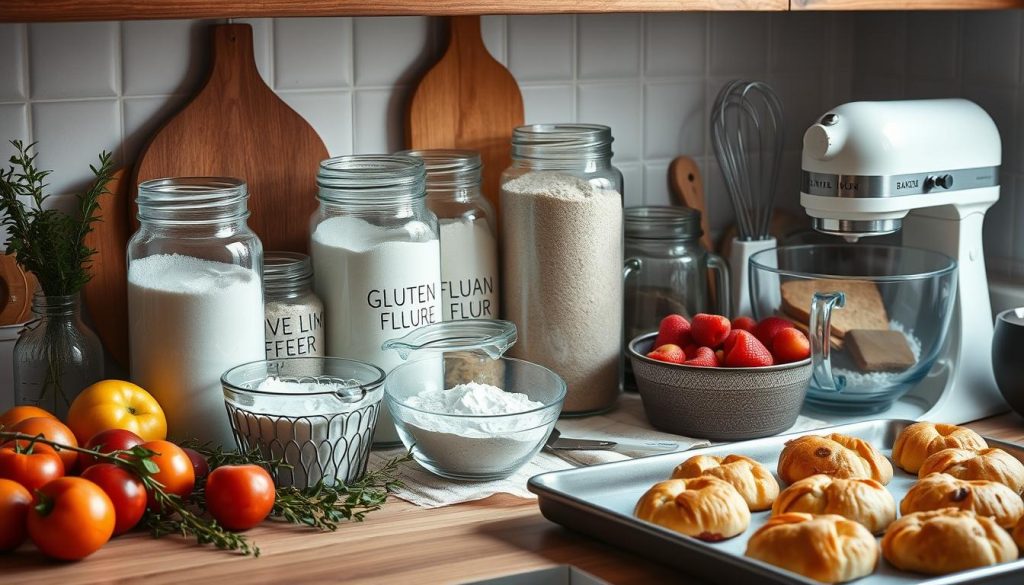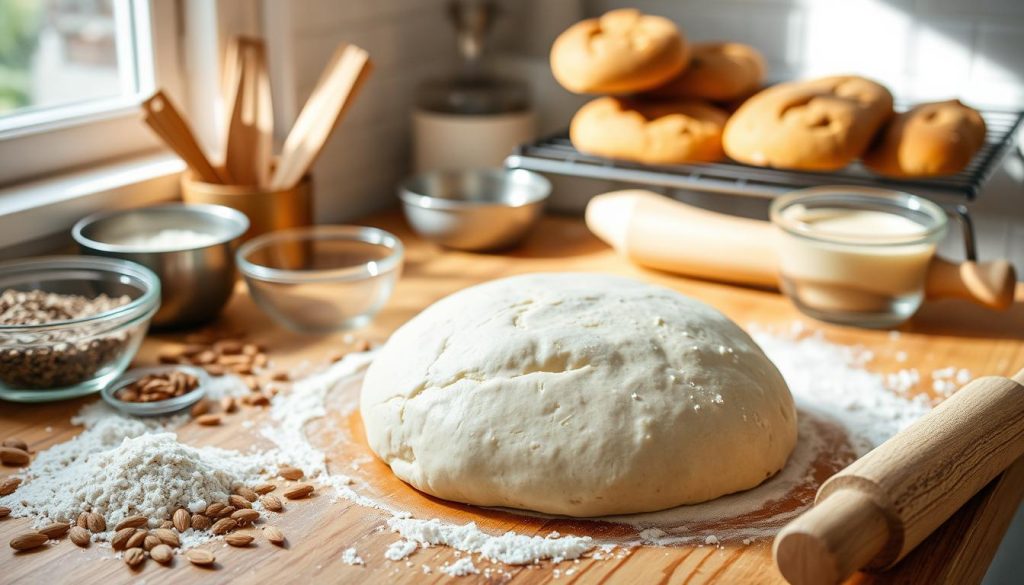
Gluten-free baking lets everyone enjoy tasty treats. It is ideal for beginners and those seeking improvement. This helpful guide provides straightforward tips, trusted methods, and creative ideas to get started.
Discover how gluten-free desserts can be just as scrumptious as the classic ones. Know the best flours and binders, the importance of texture, and the common mistakes that should be avoided. We shall guide you in making everything from fluffy cakes to crusty breads without gluten.
Understanding Gluten-free Baking Basics
Gluten-free baking is not like other bakes. It requires specific ingredients and methods. This article will guide you to bake the tastiest gluten-free treats.
What Makes Gluten-free Baking Different
Gluten makes baked products elastic. Gluten-free flours lack this property. So, we use rice, almond, or tapioca flour along with xanthan gum.
These ingredients give cakes the capacity to rise, and bread keeps its shape. You need to learn about these replacements to bake easily gluten-free.
Essential Kitchen Tools
- Digital scale: This will be necessary to get accurate measurements with gluten-free flours.
- Stand mixer: It mixes batters and doughs evenly.
- Silicone baking mats: These prevent sticking without extra grease.
- Brands like OXO and KitchenAid have some great options for these tools
Common Challenges and Solutions
Gluten-free baking can be tricky. But, with the right tips, it’s easier. Dryness is common with absorbent flours. Adding applesauce or yogurt helps.
Crumbly textures can be fixed with more eggs or flaxseed gel. For dense bread, rest the batter 30 minutes before baking. This lets flours absorb better. Try different recipe ratios to get it right.
Learning these basics is the first step to making perfect gluten-free treats. With practice, even hard recipes become easy.
Essential Gluten-free Flour Alternatives
Choosing the right gluten-free baking substitutes can make your recipes amazing. Unlike wheat flour, gluten-free ingredients need careful picking to get the right texture. Here’s a look at popular options and how to use them well.
- Almond Flour (Bob’s Red Mill): Rich in protein and healthy fats, almond flour adds moisture. It’s great for cookies and muffins, especially with xanthan gum. But, it’s too dense for bread alone.
- Coconut Flour (King Arthur): This flour soaks up a lot of liquid. Use it in small amounts and mix with eggs or flaxseed gel to avoid dryness. It’s great for pancakes and light cakes, but measure carefully as it thickens fast.
- Rice Flour (Arrowhead Mills): This is a great base for blends. Rice flour has a neutral taste. Brown rice flour adds fiber, and white rice makes for lighter textures. Mix it with potato starch to make fluffier breads.
- Oat Flour (GF Harvest): Adds chewiness to cookies and bars. Ensure it is certified gluten-free to avoid contamination. Blend with tapioca flour for better rise in cakes.
Natural Sweeteners and Flavoring Options
Make your gluten-free desserts better with depth and moisture using:
- Raw honey or maple syrup: These add subtle complexity while keeping treats soft.
- Coconut sugar: A low-glycemic alternative with caramel notes.
- Pure vanilla extract (Nielsen-Massey): Balances earthy flour flavors in cakes and brownies.
Mastering Gluten-free Bread Making

Making soft, airy gluten-free bread is all about finding the right mix of ingredients and techniques. Unlike regular bread, gluten-free baking uses special flours and binders to get that gluten-like texture. Start with a top-notch flour blend, like Bob’s Red Mill 1-to-1 or King Arthur Flour’s Gluten-Free Bread Mix. These are made to make gluten-free baking easier.
Perfect Gluten-free Pastries and Desserts
It’s all about balance in creating gluten-free desserts that are almost as good as the real deal. You need to get the flavor, texture, and the right substitutes right. With the proper ingredients and techniques, even the most delicate pastry can be tender and tasty.
Cakes and Cupcakes
For light, moist cakes, try using King Arthur’s gluten-free flour or almond flour. Add ½ tsp xanthan gum per cup of flour for structure. Lower the oven temperature by 25°F to keep them moist.
Frost them with dairy-free buttercream made from Miyoko’s vegan butter. This will give them a rich, creamy taste.
Cookies and Brownies
Chewy cookies and fudgy brownies require sticky binders such as flax eggs or Bob’s Red Mill egg replacer. Caramelize them by using coconut sugar or maple syrup, and chill for 30 minutes to stop it from spreading.
Bake these on parchment-lined pans to obtain crisp edges. A trick for perfectly browned treats.
Troubleshooting Common Gluten-free Baking Issues
Even with the best gluten-free baking ingredients, unexpected challenges can arise. Dry textures, crumbliness, or a gummy center can be frustrating results. These types of issues usually result from improper flour blends, too few binding agents, or incorrect moisture levels. It all takes patience and a few smart gluten-free baking tips.
Converting Traditional Recipes to Gluten-free
Turning family favorites into gluten-free recipes needs careful thought and creativity. Traditional baking uses wheat flour, but gluten-free recipes need different ingredients. With a few changes, your favorite dishes can be gluten-free without losing their taste or quality.
Measurement Conversions
Gluten-free flours soak up liquids differently than wheat flour. Use 140g of a gluten-free mix like King Arthur’s Measure for Measure or Bob’s Red Mill 1:1 for every cup of all-purpose flour. Add ½ teaspoon xanthan gum per cup to help with texture. Here are some good mixes:
- 40% rice flour + 30% almond flour + 30% tapioca starch
- 50% sorghum flour + 30% potato starch + 20% oat flour
Texture Modifications
Gluten-free dough crumbles or dries out. Add 1-2 tablespoons more liquid (water, milk or applesauce) to fix this. For chewy cookies or soft bread, add 1-2 teaspoons psyllium husk or gelatin. Let the batter rest for 10 minutes before baking to allow for complete hydration of flours.
Flavor Enhancement Techniques
Some gluten-free flours have an earthy or bitter flavor. Balance them with 1 teaspoon vanilla extract, citrus zest, or 2 tablespoons honey. Add flavor with toasted nuts or coconut flakes. Dutch-process cocoa does a great job in concealing bad tastes in gluten-free chocolate recipes.
Conclusion:
You can easily bake amazing gluten-free baked goods now. You have learned what flours to choose and how to modify recipes. Every attempt is an opportunity to do something better.
You can try the King Arthur Flour guides or Bob’s Red Mill mixes for fine results. Gluten-Free on a Shoestring has great fun twists on old favorites. America’s Test Kitchen books explain the science behind perfect gluten-free treats.
Don’t be shy to share your baking with others. Join local groups or online forums to swap tips. Whether it’s a hearty bread or a flaky tart, gluten-free baking is all about exploring. Try new flavors like dark chocolate or citrus zest for your next creation.
FAQ
What’s the difference with gluten-free baking?
Gluten-free baking is different because it employs special flours and binding agents. It also requires specific techniques to achieve the right texture and structure.
What are the must-haves in my kitchen for gluten-free baking?
You will need a digital scale, a stand mixer, and a blender or food processor. Also, prepare various baking pans and utensils.
What are the common challenges in gluten-free baking, and how can I overcome them?
Challenges include getting the right texture and preventing crumbliness. To overcome these, use the right flour blends and binding agents. Also, try different techniques and ingredients.
What are some of the best gluten-free flour alternatives to use in baking?
Wonderful substitutes are almond flour, coconut flour, or rice flour. Gluten-free blends of flours are also nice. Every kind of flour does have its particular advantages, so find the best according to your recipes.
What do you need for excellent gluten-free baking?
These essential ingredients are a gluten-free type of flour and binding agents as xanthan gum and natural sweeteners as honey. Never miss flavor enhancers like vanilla or cinnamon.
How do I improve my gluten-free bread-making?
Mastering gluten-free bread making is achieved by proper flours and yeast knowledge. Apply specific techniques to achieve texture and rise. Patience and experimentation are your best friends.
How can I create great gluten-free pastries and desserts?
Use the right flour blends and binding agents for making good gluten-free pastries and desserts. Experiment with techniques to achieve the right texture and flavor.
How can I troubleshoot common gluten-free baking issues?
Common issues like texture and flavor problems can be fixed by adjusting ingredients and techniques. Trial and error can help solve these issues.
How can I convert traditional recipes to gluten-free?
To convert recipes, understand measurement conversions and make texture adjustments. Use techniques to enhance flavor and structure. Remember, patience and experimentation are crucial.
